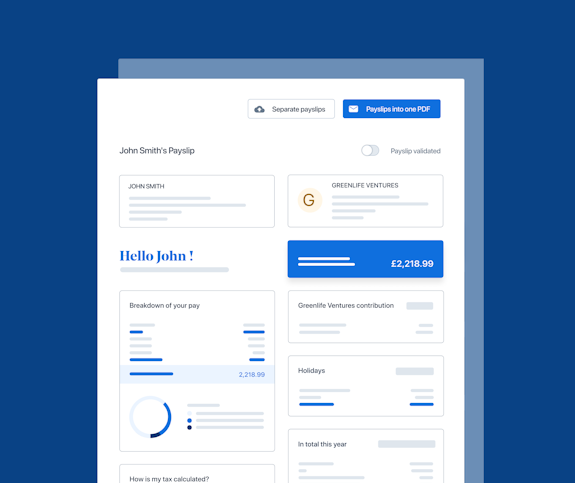- Blog
- |People management
- >Annual leave and absences
- >absence management
Absence Management in the Workplace: A Guide for UK Employers


Whether staff become unwell and need to take a leave of absence or employees are booking some annual leave days, the more staff you have, the more of a minefield managing this can become.
Not only do you have to sign off on each request, but if you don’t have comprehensive absence management software, you have to manually check your calendar to ensure there aren’t too many absences in a given time period. Then, it’s a case of adjusting payslips to reflect annual leave taken and manually calculating holiday pay.
It all sounds like a lot of work, particularly when you have other things to oversee, like recruiting, onboarding, training, and development—we’re exhausted just thinking about it! But, thankfully, there is a better way to do all of this, which we’ll touch on in this article.
What is absence management in the workplace?
Absence management refers to everything to do with absences. That includes creating and implementing absence management strategies and processes to track and monitor (and eventually improve) employee absenteeism.
You might think, ‘How important is absence management?’. Well, it seems absences in UK workplaces are rising, particularly over the past year, reaching an average of 7.8 days.
Not only are these absences costing you money and severely restricting company resources, but the other side of absence management — booking days off, making pay adjustments, etc.- is also a headache.
What is the role of HR in attendance management?
The human resources team is responsible for anything related to employee wellbeing. They create absence policies, help monitor and track absences (and their costs), identify patterns of absenteeism, and address them accordingly.
Ultimately, it's your human resources team that can help minimise and address unnecessary absences, helping your organisation save time, better manage resources and cut costs.

What is the law for leave of absence in the UK?
UK employees are entitled to various types of leave under statutory rights, including:
Statutory annual leave. Most employees are eligible to take 5.6 weeks of paid holiday entitlement each year, which equates to 28 days.
Sick leave policy. If employees are unwell, employers don’t have to pay statutory sick pay (SSP) until the employee has been off for three days straight. Employees are entitled to SSP for up to 28 weeks.
Family leave. All parents are entitled to maternity and paternity leave. They can also take shared parental leave and adoption leave.
Bereavement leave. Employees are entitled to take ‘reasonable’ time off to attend funerals or deal with family emergencies.There is no statutory right to compassionate leave.
Public duties leave. Employees called for public duties like jury service are entitled to time off for the duration of their service. It is not a legal requirement for you to pay them during this period, but many companies will continue to pay their staff.
Your company might decide to offer more than the statutory minimum, e.g. paying more for maternity leave or extending sick leave entitlement.
How to better manage absence in the workplace
If you think your absence management could be better, it probably could be. Here are several ideas to help you improve your absence management practices.
1. Make sure you create clear policies and procedures
From how employees report an absence to outlining acceptable reasons for it can help employees understand what’s expected of them. When employees understand your absence management policy, reporting an absence becomes standardised, which means little human intervention is required from HR.
2. Invest in an absence management system that helps track and monitor absences
Tracking and monitoring absences is how you spot trends and patterns. Spotting these patterns early can help you remain proactive rather than reactive in your management techniques. If you notice a particular department has had bouts of absenteeism caused by stress, you can investigate further to make positive changes to the workforce.
Look for a system that:
Automates the leave request process, empowering employees
Helps you create customised leave policies
Integrates with Payroll for automatic holiday/leave pay calculations
Monitors absences in real-time
Offers compliance support regarding UK regulations i.e. sick leave and parental leave
P.S. PayFit can do all of this and more!
3. Craft a standardised back to work process
Returning to work after any absence (particularly extended absences) can be daunting for employees. You want them to know you’re here to support them in any way you can and help them readjust to the work environment.
Take time to conduct back-to-work interviews with each employee so you can track their process. Schedule regular catch-ups and check-ins to ensure they’ve got everything they need.
4. Train your line managers
Managing leave & absences requires a little bit of sensitivity and understanding. And if your line managers aren't currently delivering this, it's time to train them how to better manage sickness absences.
Employees need to feel comfortable enough to approach their line manager when reporting illness or issues. So take time to fully prep all managers to ensure each situation is managed correctly.
5. Implement wellbeing initiatives
Companies like Heka offer flexible wellbeing programs companies can buy into from menopausal support and fertility consultations to nutritional advice and therapy and everything in between.
Investing in your employees can help your workforce in the long run. Not only do you build a reputation for caring about your employees, but initiatives like this can help attract and retain the best talent to keep you competitive in the marketplace.

Six benefits of improving your sickness and absence management
Cut down on HR admin by embracing automation and tracking. By cutting down on manual admin tasks, your HR teams can focus on implementing new processes and other value-add tasks.
Improve resource management and allocation with clear policies. Finding cover at the last minute can be stressful and sometimes impossible, but if employees understand your leave policies clearly, you can minimise last minute leave requests.
Reduce costs associated with absenteeism. Absenteeism can cause resource allocation problems. But better managing absences and reducing absenteeism can help reduce costs through staff retention (no recruiting costs), projects completed on time (your bottom line doesn’t take a hit) and improved productivity (everything’s more efficient).
Improve employee engagement. By improving the back-to-work process and understanding absenteeism trends, you can implement better practices and introduce more relevant initiatives to help improve the workplace environment for everyone.
Identify and address workplace issues quickly. Being able to accurately track and monitor absence data in real-time helps you spot trends and patterns quickly, making how you manage absences more flexible and proactive.
Stay compliant with UK regulations around leave. Non-compliance can leave you open to fines and penalties. Instead, using an HR payroll system that keeps you compliant with all kinds of leave regulations means you have peace of mind.
Before you go…
How you manage absences can have a significant effect on your workforce morale. Having clear policies and procedures in place means everyone knows what’s expected of them, including how to book and manage their time off effectively.
But to implement these changes, you need to find an absence management software that helps, not hinders, your productivity.
See how PayFit can simplify and streamline your absence management processes. Book a demo to see our HR features in action.


A UK 4-Day Working Week - Thoughts On Labour’s Plan

Running payroll - A Guide For New Businesses

The Alabaster Ruling & Maternity Pay - A Guide For Employers

The End Of Zero Hours Contracts? Implications For Businesses

What is the HM Revenue and Customs Starter Checklist

